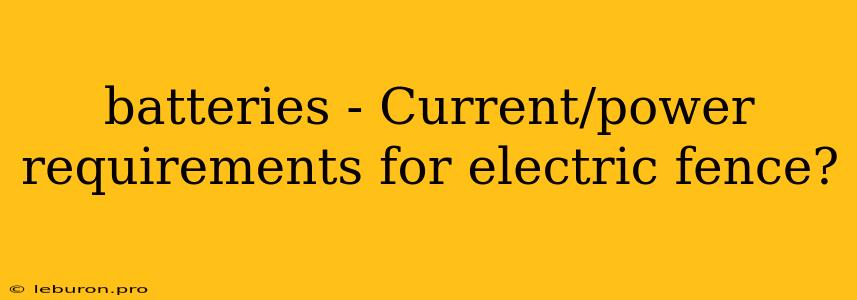Electric fences are an effective way to deter animals from entering a specific area. They work by delivering a brief, low-energy electrical pulse to deter animals from crossing the fence line. The effectiveness of an electric fence depends on several factors, including the type of fence, the type of animal, and the batteries used to power the fence. One crucial consideration is the current/power requirements for electric fence operation, which we will explore in detail in this article.
Understanding the Basics of Electric Fence Power
Electric fences work by creating an electric field that delivers a short, sharp shock to any animal that touches the wire. The strength of this shock, and therefore the effectiveness of the fence, is determined by the voltage and current flowing through the fence wire.
Voltage vs. Current
- Voltage refers to the electrical potential difference between the fence wire and the ground. It is measured in volts (V). Higher voltage creates a stronger electric field, resulting in a more noticeable shock.
- Current, measured in amperes (A) or milliamperes (mA), represents the flow of electrical charge through the fence wire. The amount of current determines the intensity of the shock delivered.
Power and Resistance
The relationship between voltage, current, and power is described by Ohm's law:
Power (P) = Voltage (V) x Current (I)
Power, measured in watts (W), represents the rate at which energy is transferred. Higher power generally indicates a stronger electric fence. However, the electrical resistance of the fence wire and the ground also plays a significant role in the effectiveness of the fence.
Factors Influencing Current/Power Requirements for Electric Fence
The specific current/power requirements for electric fence vary based on several factors:
1. Fence Length and Wire Type
- Longer fences require more power. The longer the fence, the greater the resistance it presents, leading to a drop in current.
- Thicker wire has lower resistance. A thicker wire allows for a higher current flow, leading to a stronger shock. Conversely, thinner wires will have a higher resistance, requiring more power to deliver an adequate shock.
2. Type of Animal
- Larger and heavier animals need a stronger shock. Larger animals have a higher threshold for pain, requiring a stronger electrical pulse to deter them.
- Different animal species have varying sensitivities to electric shock. For instance, pigs and horses are generally more sensitive than cattle.
3. Vegetation and Ground Conditions
- Heavy vegetation can increase resistance. Vegetation touching the fence wire can reduce the current flow and weaken the fence's effectiveness.
- Moist soil has lower resistance. Dry soil can increase resistance, requiring more power to deliver an adequate shock.
4. Climate and Weather
- Extreme temperatures can affect battery performance. Cold temperatures can reduce battery efficiency, while heat can shorten their lifespan.
- Heavy rainfall can create short circuits. Water conducting electricity can create a path to ground, bypassing the fence wire and reducing the shock intensity.
Batteries for Electric Fences
Batteries are the primary source of power for electric fences. They come in various types, each with different specifications and performance characteristics. Common battery types include:
1. Lead-Acid Batteries
- Widely available and affordable. Lead-acid batteries are the most common type used for electric fences.
- Heavy and require maintenance. They need to be regularly checked for electrolyte levels and topped up with distilled water.
- Prone to freezing. In cold climates, they may require extra precautions to prevent freezing.
2. Sealed Lead-Acid Batteries
- Maintenance-free and spill-proof. Sealed lead-acid batteries are a good option for remote or inaccessible locations as they don't require regular maintenance.
- Lower capacity than traditional lead-acid. They typically have a shorter lifespan than traditional lead-acid batteries.
3. Lithium-ion Batteries
- High capacity and long lifespan. Lithium-ion batteries offer excellent performance with a long lifespan and a high power output.
- More expensive than other options. Lithium-ion batteries are typically more expensive than lead-acid batteries.
Choosing the Right Battery for Your Electric Fence
When choosing a battery for your electric fence, consider the following:
- Fence size and power requirements. A larger fence will require a battery with a higher capacity.
- Animal type and sensitivity. The size and sensitivity of the animals you are deterring will influence the required power output.
- Climate and weather conditions. Choose a battery suitable for the climate in your area.
- Budget and maintenance considerations. Balance the cost of the battery with its lifespan and maintenance requirements.
Current/Power Requirements for Electric Fence
It is important to understand the current/power requirements for electric fence to ensure it is operating effectively. The power requirements are typically expressed in joules (J) or millijoules (mJ).
- Low-energy fences: Generally used for small animals like rabbits and poultry, these fences require 0.5-1 joule (J) of energy per pulse.
- Medium-energy fences: Suitable for larger animals like sheep and goats, these fences require 1-2 joules (J) per pulse.
- High-energy fences: Designed for large animals such as cattle and horses, these fences require 2-5 joules (J) per pulse.
Conclusion
The current/power requirements for electric fence are crucial for its effectiveness. By understanding the factors influencing power requirements, including fence length, animal type, and environmental conditions, you can select the appropriate batteries and ensure your fence delivers the necessary shock to deter unwanted animals. Remember, choosing the right batteries and properly maintaining your electric fence is essential for its long-term effectiveness and safety.
